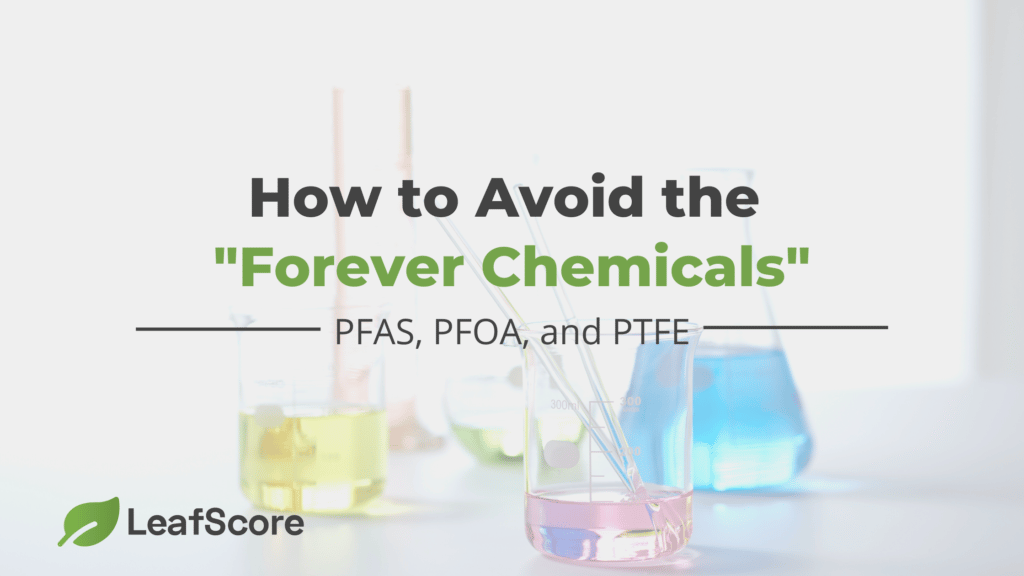In increasing numbers, consumers want to avoid the ominously named “forever chemicals,” PFAS, PFOA, and PTFE. In this post, we explain the difference between PFAS, PFOA, and PTFE, as well as how to avoid them in your everyday life.

Table of Contents
If you’ve heard the term ‘forever chemicals’, you’ve heard about PFAS. This group of manmade chemicals garnered the nickname because most don’t break down, ever.
This means PFAS remain in the environment forever, continuing to affect human health and the wider environment.
What are PFAS, PFOA, and PTFE, though, and how can we break up with forever chemicals?
- More than 9,000 substances exist in the PFAS “family” of toxic compounds.
- PFAS are labeled “forever chemicals” because they stay in the environment forever.
- The EPA recognizes the danger posed by PFAS, especially in drinking water.
- PFOS and PFOA are less commonly used these days, largely because of the growing recognition of the health effects of these chemicals.
- However, the most common place to find PFAS is in items with water-repellent and stain-repellent treatments. Think rain pants, period underwear, waterproof shoes and boots, lunch boxes and bags, pencil cases, gym bags, yoga mats, tents, kayak covers, and so forth.
- PTFE is a more stable, but still toxic, forever chemical, often marketed as safe in “teflon-free” cookware.
What are PFAS, PFOA, and PTFE?
PFAS stands for per- and polyfluoroalkyl substances, of which there are more than 9,000. This group of chemicals contain a strong carbon-fluorine bond which is hard to break, meaning they tend to accumulate in animal tissue and in the environment.
PFOA (perfluorooctanoic acid, or C8) is one of the most common types of PFAS found in the environment. This chemical, along with the very similar PFOS (perfluorooctane sulfonate), was once used widely in household products such as stain-resistant carpeting and couches, other household textiles, household cleaning products, and in firefighting foams.
PFOS and PFOA are less commonly used these days, largely because of growing recognition of the health effects of these chemicals.
What about PTFE?
PTFE stands for polytetrafluoroethylene and is a chemical once used alongside PFOA to produce Teflon, Dupont’s patented non-stick chemical coating used in a lot of cookware and bakeware. Because of concerns over the health effects of PFOA, manufacturers began making PFOA-free non-stick cookware in recent years. The trouble, though, is that this cookware isn’t necessarily PTFE-free, meaning many of the same health concerns remain.
Where are PFAS found in the home?
We’ve already mentioned non-stick pans, but this isn’t the only place you’ll find PFAS in most homes. PFAS are also present in food wrappers, especially in takeout containers, some disposable plates and cups (including some ‘compostable’ ones!), microwaveable popcorn bags, pizza boxes and burger wrappers, and candy wrappers.
You’ll also find PFAS in some cosmetics, sometimes on purpose and sometimes through contamination. You may even have a carpet, mattress, or furniture with a stain-repellent PFAS coating. This is more common in outdoor rugs and furniture, or in items advertised as being easy to clean and (ironically) great for homes with pets and kids. Some household cleaning products also contain PFAS, as does some dental floss and toothpicks.
The most common place to find PFAS, though, is in items with water-repellent and stain-repellent treatments. Think rain pants, period underwear, waterproof shoes and boots, lunch boxes and bags, pencil cases, gym bags, yoga mats, tents, kayak covers, and so forth.
Chances are that every active, outdoorsy household has at least some hiking, camping, or other sports equipment with a PFAS-based waterproof coating.
Free eBook: Simple Steps to a Greener Home
Concerned about climate change? Learn actionable tips for making each room in your home greener.
"*" indicates required fields

How we’re exposed to PFAS
PFAS has been detected in the blood of most adults and children in the U.S. Scientists also found PFAS in umbilical cord blood and breast milk.
Forever chemicals are present in a huge number of everyday products. We could just as easily call them ‘everywhere chemicals’, given their ubiquity. This means that PFAS are present in household dust that we breathe in every day. We can also absorb PFAS through our skin.
Even if we’re exceptionally careful about avoiding products made with PFAS, we can still be exposed through drinking water and food. Researchers found that Michigan beef was contaminated with PFAS, for instance. The EWG also found PFAS contamination in drinking water systems in all 50 states and in Guam and Puerto Rico.
If you’re thinking this is a good reason to switch to bottled water, think again. The U.S. Food and Drug Administration doesn’t enforce a limit on PFAS in bottled water and a 2021 study revealed PFAS contamination in 39 of 100 products sampled.
Why all this contamination? In large part because PFAS are present in manufacturing wastewater, firefighting foam, and run-off from washing household products. PFAS also enter waterways, air, and soil from landfills and waste disposal facilities, recycling facilities, and sewage treatment plants, with little or no filtration or testing for these chemicals in most drinking water systems.
If you live near a military base, airport, or a training facility for firefighters, chances are the local groundwater contains PFAS. If I lived near one of these, I would definitely filter my water to minimize PFAS exposure.
As with many environmental health issues, people of color and other marginalized groups are most likely affected by greater PFAS exposure. This is because many low-income communities and communities of color are located near to contaminated industrial sites, military bases, and so forth.
Free eBook: Simple Steps to a Greener Home
Concerned about climate change? Learn actionable tips for making each room in your home greener.
"*" indicates required fields

The dangers of PFAS
PFAS bioaccumulate, which basically means the body can’t easily eliminate PFAS, so they build up over time. This also happens in non-human animals, including those many humans eat, offering another route of exposure.
Why does PFAS exposure matter? The biggest reason is that these are endocrine disruptors that affect the body’s hormonal system. PFAS can affect reproductive health, growth, and metabolism and are linked to a variety of health issues.
I’ve written more extensively about the problems with Teflon here.
How to avoid PFAS
One way to minimize PFAS exposure is to be skeptical of claims that a product is PFOA-free or PTFE-free. Such claims often just mean the produce contains another type of PFAS. Unless something says it is PFAS-free and is tested by a third-party, it’s best to assume at least some degree of intentional PFAS use in easy-clean, water-resistant, or stain-resistant products.
Even in products that don’t have such qualities intentionally, chances are there’s some unintended contamination with PFAS. For instance, some cosmetics pick up PFAS from packaging or during manufacturing through contact with machinery.
Sadly, we have to accept that some exposure to PFAS is inevitable in modern life. Here are 10 ways to reduce your exposure to PFAS:
- Avoid products with water-repellent and stain-repellent qualities (unless they’re certified PFAS-free)
- Limit use of waterproof clothing, footwear, and other products that aren’t certified as PFAS-free
- Where necessary, choose products made with recycled synthetic materials that are inherently waterproof or stain resistant
- Avoid leather goods – while leather seems natural, leather tanning often uses PFAS and other toxic chemicals
- Avoid prepackaged food in greaseproof bags and containers (take your own containers for takeout and grocery shopping!)
- Choose BPI-certified compostable packaging that is PFAS-free
- Avoid non-stick cookware that isn’t PFAS-free (use cast iron, ceramic, stainless steel, and glass instead
- Choose personal care and cosmetic products that are PFAS-free or, at minimum, free of ‘perfluor-‘ and ‘polyfluor-‘ ingredients
- Test your household water for PFAS or get results of municipal testing
- Use a water filter for your whole home (reverse osmosis and two-stage filters are best at removing PFAS).
Finally, to help everyone cut their risk of PFAS exposure, ditch fossil fuels. Oil and gas companies use PFAS in the fracking process, as reported by the group Physicians for Social Responsibility. Another reason to go solar at home and to have your next vehicle be an EV!